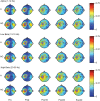Aerobic exercise and action observation priming modulate functional connectivity
- PMID: 37023070
- PMCID: PMC10079047
- DOI: 10.1371/journal.pone.0283975
Aerobic exercise and action observation priming modulate functional connectivity
Abstract
Aerobic exercise and action observation are two clinic-ready modes of neural priming that have the potential to enhance subsequent motor learning. Prior work using transcranial magnetic stimulation to assess priming effects have shown changes in corticospinal excitability involving intra- and interhemispheric circuitry. The objective of this study was to determine outcomes exclusive to priming- how aerobic exercise and action observation priming influence functional connectivity within a sensorimotor neural network using electroencephalography. We hypothesized that both action observation and aerobic exercise priming would alter resting-state coherence measures between dominant primary motor cortex and motor-related areas in alpha (7-12 Hz) and beta (13-30 Hz) frequency bands with effects most apparent in the high beta (20-30 Hz) band. Nine unimpaired individuals (24.8 ± 3 years) completed a repeated-measures cross-over study where they received a single five-minute bout of action observation or moderate-intensity aerobic exercise priming in random order with a one-week washout period. Serial resting-state electroencephalography recordings acquired from 0 to 30 minutes following aerobic and action observation priming revealed increased alpha and beta coherence between leads overlying dominant primary motor cortex and supplementary motor area relative to pre- and immediate post-priming timepoints. Aerobic exercise priming also resulted in enhanced high beta coherence between leads overlying dominant primary motor and parietal cortices. These findings indicate that a brief bout of aerobic- or action observation-based priming modulates functional connectivity with effects most pronounced with aerobic priming. The gradual increases in coherence observed over a 10 to 30-minute post-priming window may guide the pairing of aerobic- or action observation-based priming with subsequent training to optimize learning-related outcomes.
Copyright: © 2023 Mark et al. This is an open access article distributed under the terms of the Creative Commons Attribution License, which permits unrestricted use, distribution, and reproduction in any medium, provided the original author and source are credited.
Conflict of interest statement
The authors have declared that no competing interests exist.
Figures






Similar articles
-
A Comparison of Primed Low-frequency Repetitive Transcranial Magnetic Stimulation Treatments in Chronic Stroke.Brain Stimul. 2015 Nov-Dec;8(6):1074-84. doi: 10.1016/j.brs.2015.06.007. Epub 2015 Jun 22. Brain Stimul. 2015. PMID: 26198365 Free PMC article.
-
A short bout of high-intensity exercise alters ipsilesional motor cortical excitability post-stroke.Top Stroke Rehabil. 2019 Sep;26(6):405-411. doi: 10.1080/10749357.2019.1623458. Epub 2019 May 30. Top Stroke Rehabil. 2019. PMID: 31144609 Free PMC article.
-
Physical activity levels determine exercise-induced changes in brain excitability.PLoS One. 2017 Mar 9;12(3):e0173672. doi: 10.1371/journal.pone.0173672. eCollection 2017. PLoS One. 2017. PMID: 28278300 Free PMC article.
-
Theta priming of 1-Hz rTMS in healthy volunteers: effects on motor inhibition.J Clin Neurophysiol. 2013 Feb;30(1):79-85. doi: 10.1097/WNP.0b013e31827ed0e3. J Clin Neurophysiol. 2013. PMID: 23377446
-
How different priming stimulations affect the corticospinal excitability induced by noninvasive brain stimulation techniques: a systematic review and meta-analysis.Rev Neurosci. 2018 Nov 27;29(8):883-899. doi: 10.1515/revneuro-2017-0111. Rev Neurosci. 2018. PMID: 29604209
Cited by
-
Cross-Frequency Coupling as a Biomarker for Early Stroke Recovery.Neurorehabil Neural Repair. 2024 Jul;38(7):506-517. doi: 10.1177/15459683241257523. Epub 2024 Jun 6. Neurorehabil Neural Repair. 2024. PMID: 38842027 Free PMC article.
-
Physical exercise for brain plasticity promotion an overview of the underlying oscillatory mechanism.Front Neurosci. 2024 Aug 8;18:1440975. doi: 10.3389/fnins.2024.1440975. eCollection 2024. Front Neurosci. 2024. PMID: 39176382 Free PMC article. Review.
-
A 12-week in-phase bilateral upper limb exercise protocol promoted neuroplastic and clinical changes in people with relapsing remitting multiple sclerosis: A registered report randomized single-case concurrent multiple baseline study.PLoS One. 2024 Oct 17;19(10):e0299611. doi: 10.1371/journal.pone.0299611. eCollection 2024. PLoS One. 2024. PMID: 39418242 Free PMC article. Clinical Trial.
References
-
- Nowak DA, Grefkes C, Dafotakis M, Eickhoff S, Küst J, Karbe H, et al.. Effects of low-frequency repetitive transcranial magnetic stimulation of the contralesional primary motor cortex on movement kinematics and neural activity in subcortical stroke. Arch Neurol. 2008;65(6):741–7. doi: 10.1001/archneur.65.6.741 - DOI - PubMed

